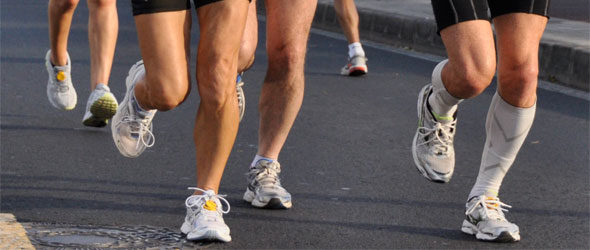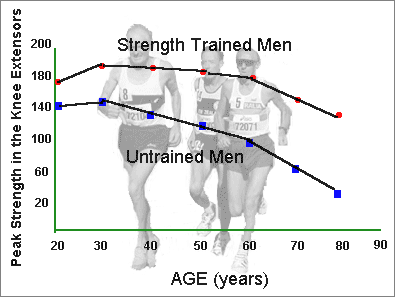Changes in Muscular Strength
It is well documented that a person’s maximal strength decreases with increasing age. Is this due to Ageing or a decrease in physical activity? The answer appears to be BOTH.
From the figure below, it is apparent that strength training remains highly effective in maintaining muscular strength throughout life. However, after about age 60, strength levels fall more rapidly, independent of training. This is probably influenced by marked changes in the hormonal mileau. Both testosterone and growth hormone appear to decline more dramatically after about age 60. The decreased strength is due to atrophy of muscle fibers. It is important to notice that with strength training, the maximal strength of a 60 year old can exceed that of his untrained sons! And, several studies have demonstrated that strength gains are possible even into the 90s. So it is never too late to begin a strength training program!
Fiber Type and Aging
There have been conflicting reports and myths developed regarding fiber type changes with age. Cross-sectional studies of post-mortem bodies between age 15 and 83 have suggested that fiber type composition is unchanged throughout life. This is also supported by comparing muscle bioopsy results of younger and older endurance athletes. In contrast, one longitudinal study of a group of runners examined in 1974 and again 1992, suggested that training could play a role in fiber distribution. Those athletes who continued training showed unchanged fiber composition. Those who stopped training appeared to have greater slow twitch fiber percentage. This is primarily due to selective atrophy of the fast fibers. This is not difficult to explain since they are seldom recruited. There is also some evidence that the actual number of fast motor units decreases slightly with aging after age 50, about 10% per decade. The reasons or mechanisms for such a change are unclear. So, the net effect of aging for the endurance athlete is unchanged fiber composition or a slight relative increase in Slow fiber type due to selective Fast fiber loss. The Fast motor units do not become Slow motor Units.
Muscle Endurance Capacity and Ageing
The good news for the endurance athlete is that there appears to be little change in skeletal muscle oxidative capacity with age, as long as training is maintained. The number of capillaries per unit area of muscle is the same in young and old endurance athletes. Oxidative enzyme levels are similar or slightly lower in older athletes. This small decrease is probably attributable to decreased training volume in the older athletes. Furthermore, it appears that the older individual who starts endurance training retains the potential to improve muscle endurance capacity.
Summary
It appears that the Masters athlete who continues endurance training at high intensities and maintains a maintenance strength training program experiences few changes in skeletal muscle through age 50. After age 50, declines in the quantity, but not the quality of muscle occur. These declines are also diminished by continued training. In general the changes that occur diminish maximal strength and power more than endurance capacity. This helps to explain the tendency for older athletes to more toward longer events within their sports discipline.
source : Copyright Stephen Seiler All Rights Reserved























